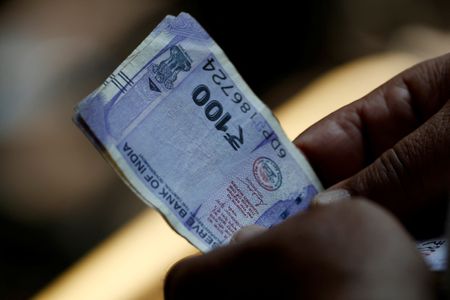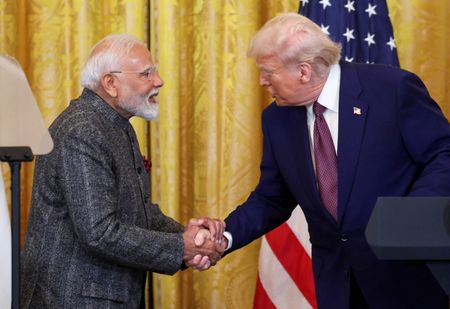By Jaspreet Kalra
MUMBAI (Reuters) –
The Indian rupee closed weaker on Wednesday, although dollar sales by foreign banks capped its losses as markets await the announcement of U.S. reciprocal levies that could stoke global trade tensions further and weigh on economic growth.
The rupee ended at 85.4975 against the U.S. dollar, down slightly from 85.47 in the previous session.
The White House will announce fresh duties on U.S. imports at 2000 GMT, with the tariffs expected to take effect immediately.
However, market indicators are signalling that rupee traders are not too bothered by tariff risks. Overnight options are pricing in a 25-30 paisa swing following the announcement, only a tad higher than the rupee’s average intraday range of 21 paisa this year so far.
The “market expects a lot of bargaining once tariffs are announced,” a trader at a Singapore-based hedge fund said. On the rupee, traders are mostly holding small positions heading into the event risk, they added.
On Wednesday, the rupee’s decline was likely cushioned by foreign portfolio inflows, a salesperson at a large foreign bank said. Asian currencies were mostly rangebound, while the dollar index treaded water around the 104.2 mark.
Meanwhile, India’s benchmark bond yield declined over 8 basis points to 6.4964% on optimism over rate cuts by the central bank.
“All told, we believe the financial markets are under-estimating the scale of action,” MUFG Bank said in a note.
“A swathe of levies capturing all the major trading partners with a 20%-25% tariff would be seen as most aggressive and likely elicit the biggest risk-off reaction,” the note added.
In its latest report, the office of the United States Trade Representative highlighted concerns that some of India’s import requirements are not internationally aligned, and that some are burdensome or lack clear timelines.
(This story has been refiled to correct bond market levels in paragraph 7)
(Reporting by Jaspreet Kalra; Editing by Sonia Cheema)











